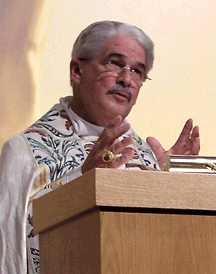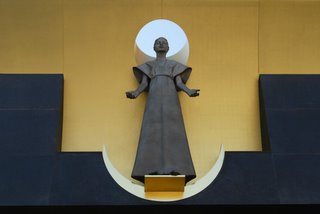Wicca and Paganism Growing
 Zenit has an interesting report on the growing influence of Wicca in Europe and America. If Ms. Sanders' conclusions are correct, the Church is largely to blame for this growth. We are failing to take the Good News to teens and young adults effectively, especially when it comes to young women. Anglo-Catholics will note with particular interest her conclusion that "Modern church culture ... has reduced the importance of religious rituals and solemn celebrations, leading people to look for alternatives that offer more tangible supernatural experiences." The report makes for sobering reading. It notes, for example:
Zenit has an interesting report on the growing influence of Wicca in Europe and America. If Ms. Sanders' conclusions are correct, the Church is largely to blame for this growth. We are failing to take the Good News to teens and young adults effectively, especially when it comes to young women. Anglo-Catholics will note with particular interest her conclusion that "Modern church culture ... has reduced the importance of religious rituals and solemn celebrations, leading people to look for alternatives that offer more tangible supernatural experiences." The report makes for sobering reading. It notes, for example:The practice of witchcraft is attracting ever-growing numbers, particularly among young women. A recent attempt to understand its appeal is the book "Wicca's Charm," published in September by Shaw Books. Authored by journalist Catherine Edwards Sanders, the book stemmed from a magazine article she was commissioned to do. Initially dismissive of Wicca, during her subsequent research Sanders came to appreciate that a genuine spiritual hunger was leading people into neo-pagan practices.
Sanders, a self-professed Christian, defines Wicca as a "polytheistic neo-pagan nature religion inspired by various pre-Christian Western European beliefs, which has as its central deity the Mother Goddess and which includes the use of herbal magic." The book, which is limited to examining the situation in the United States, admits it is difficult to estimate the number of Wicca adherents. Sanders cites an estimate from one group, the Covenant of the Goddess, which claims around 800,000 Wiccans and pagans in America. A sociologist, Helen Berger, in 1999 put the estimate at 150,000 to 200,000 pagans.
Wicca is made up of many diverse elements, yet Sanders identifies some common beliefs among its followers. They are: All living things are of equal value and humans have no special place, and are not made in God's image; Wiccans believe that they possess divine power within themselves and that they are gods or goddesses; their own personal power is unlimited by any deity; and consciousness can and should be altered through the practice of rite and ritual. What is important to Wiccans, Sanders explains, is the experience of a spiritual reality, and not truth or a body of knowledge. There is no orthodoxy, defined text, or core beliefs. And, while it has ancient roots, Sanders notes it is attractive to modernity since it can be freely molded to fit the spiritual consumer's desires.
Spell-making is another key element of Wicca. But Sanders notes that of all the Wiccans she spoke to, none entered it in order to use spells to harm people. Most choose Wicca because they are dissatisfied with churches and organized religion and are looking for a spiritual experience they are unable to find elsewhere.
Earthy
Another common trait in Wicca is environmentalism. Modern life has lost its connection to the land, Sanders argues, and Wicca, with its emphasis on nature, seasonal calendars, and the celebrations linked to the changing of the seasons, is both a way to recover this connection and also to spiritualize the relationship with the earth. Many Wiccans also reject the materialistic (but not spiritual) consumer culture. Pagan and Wiccan groups, in fact, have been present at some of the anti-globalization protests in recent years. Sanders describes some the ceremonies she witnessed in 2002 during the World Economic Forum meeting in New York. They drew attention to such matters as environmental damage, animal welfare and preserving the purity of the water supply.
The ecological aspect of Wicca draws inspiration in part from the so-called Gaia spirituality. Gaia was the earth goddess of the ancient Greeks and in neo-pagan circles she is now transformed into the idea of the earth being one living organism, also called Gaia.
Feminism is another important element attracting people to Wicca. Sanders observes that Wiccan women feel as if Christian churches treat them like second-class citizens, limited to teaching Sunday school. Sanders estimates that around two-thirds of neo-pagans in the United States are female. Many of them practice a form of goddess worship, commonly in the form of a mother goddess who is a metaphor for the earth. The Wiccan rituals also emphasize the concept of empowerment, and the female biological functions are accorded a respected role. Added to this is the belief that what today's goddess worshippers are doing is reclaiming the heritage of a primitive world in which a peaceful matriarchal society dominated. This "matriarchal myth" is short on any historical evidence, notes Sanders, but is nonetheless an affirmation that is commonly repeated.
In fact, Sanders devotes a section of the book explaining how the Wiccan rituals and spells have no roots prior to 1900, and are the result of inventions and adaptations by a group of men, notably Aleister Crowley and Gerald Gardner. Far from being a revival of some ancient paganism or matriarchal society, Wicca is a modern, male invention.
Spiritual hunger
The desire to experience spirituality in a more direct and intense way is another factor attracting people to Wicca. Some teen-age girls, Sanders notes, are unsatisfied with the superficial teen culture and are looking for something to give a deeper meaning to their lives. But, instead of turning to traditional religion to satisfy this need, an increasing number experiment with Wicca. Sanders argues that in part this is the fault of some churches, which have lost sight of the unseen world and the reality of a relationship with Christ and the indwelling of the Holy Spirit, reducing their activities to just a social exercise.
Other churches provide little in the way of serious nourishment for inquiring teen-age minds, particularly females ones. Another factor leading adolescents to Wicca instead of Christianity is a desire for rituals and ceremonies. Modern church culture, observes Sanders, has reduced the importance of religious rituals and solemn celebrations, leading people to look for alternatives that offer more tangible supernatural experiences.






